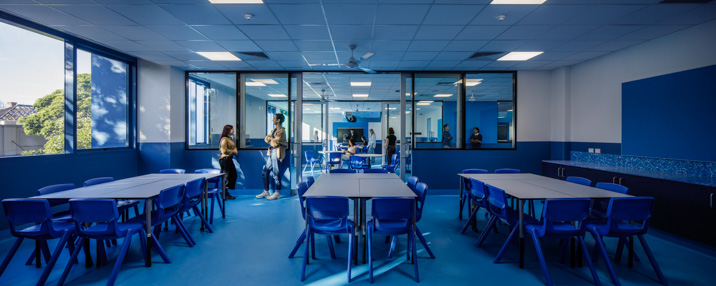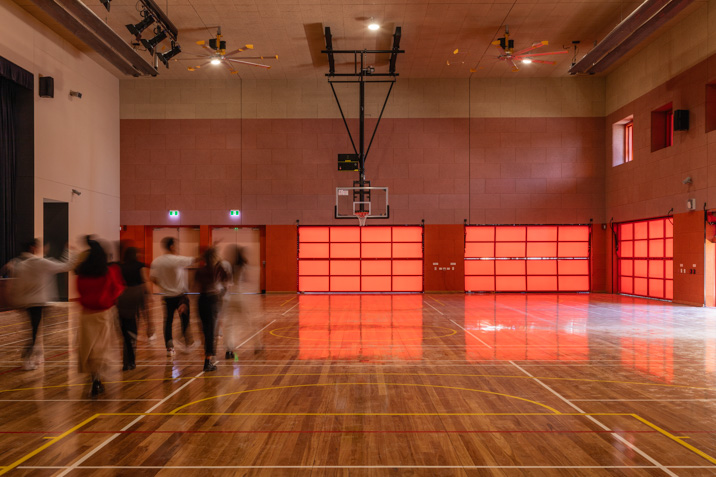From the architect:
Heritage, landscape and the creativity of its students have inspired Woods Bagot’s design of an extension to Mosman High School on Sydney’s Lower North Shore.

Georgia Singleton, Global Leader of Education and Science at Woods Bagot, says the outcome embodies Mosman High School’s performing arts values, the rich Indigenous significance of the site and a vision of future learning.
In simple terms it’s a versatile four-storey multi-purpose building positioned high on the Middle Harbour peninsula with a gross floor area of 8800 square metres that lifts the in-demand school’s student capacity from 1100 to 1200.
It includes classrooms, performance and fitness studios, staff rooms, canteen, a gym that can be used for student productions or assemblies, a theatre, terraces on the two highest levels and a rooftop games court with sweeping views of the city and North Head.


“We’ve been doing quite a few schools around New South Wales and the central idea has been around equity and equality among the kids, however, there are some exceptions where a school has a refinement or specialty,” says Singleton.
“Mosman is a performance school – Naomi Watts went there and so did few other quite famous actors and musicians*. There’s a lot of music, and that really shifted the way we looked at the design.
“We felt it should open itself to the outside while in the architecture we had to talk about the school’s playful and creative character.”
This is immediately apparent with the bold exterior, set back from busy Military Road to enable the retention of existing vegetation including numerous mature trees which provide solar shading and noise mitigation.


The new building is encased in a brick “crust” built from four different brick types, 10 percent of which are glazed, referencing Mosman’s heritage shopping strip while sitting comfortably beside the original school brick building, now 140 years old.
Colours inspired by the vibrant local landscape are immediately brought into play with the brick exterior punctuated by a seemingly random but carefully considered pattern of windows framed by bright metal shrouds that pop against the darker background.
At several points there are large “peel out” floor-to-ceiling rectangular windows that break up the façade and Connect with Country by responding to key views over the Mosman peninsula and Sydney Harbour.


“That part of Mosman has a deep Indigenous history and was used as a performance and learning space for local Aboriginal people,” says Singleton. “It was about reaching out towards the landscape and celebrating the inside and outside together.”
The colour of the bricks and window shrouds reflects the history of Mosman. “I went and photographed all the colours and they can all be found in the facade. You can see the terracotta, the reds, yellows and blues.”
Singleton says designing around the existing landscape “makes the building playful and also cracked it open to create visual connectivity”.

Continuing the inside-outside theme, the façade colours are used throughout the interior, differentiating learning zones – bright for the performance areas and calm blues and greens for more traditional subjects such as science.
Project leader Zie Liu said phase one of the project involved the demolition of an existing building before construction of the new structure could begin. The process took Multiplex 18 months with students moving in the third week of July.
“The main design challenge was how to design a school building within a heritage conservation area in close proximity to the original school building which was built in 1883,” says Liu.

“We responded by doing a brick façade, picking bricks with similar colours to the existing building but arranged in a completely different way – it’s a contemporary reading.”

